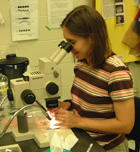
Katherine Himes
Thesis Title:
A Study of the Cellular Changes Associated with Ganglionic Migration and Fusion during Development of the Moth, Manduca sexta
Current Position:
Science & Technology Diplomacy Fellow, American Association for the Advancement of Science (AAAS) at United States Agency for International Development (USAID)
Undergraduate Institution and Major/Degree:
- University of Minnesota, BS, Neuroscience (Magna Cum Laude), 1999
- University of WI-Madison, MBA, Entrepreneurship, 2001
Major Advisor(s):
Karen Mesce, Ph.D.
Research Description:
The hawkmoth, Manduca sexta, is an insect model that enables me to examine development of the central nervous system (CNS). Nervous system assembly, in all animals, involves multiple interactions between neurons, and between neurons and supporting cells, the glia.
As the animal develops from the larval to adult form, dramatic changes in its nervous system are observed. Some larval neurons (not needed by the
adult) undergo developmentally programmed cell death, while others are retained and re-modeled; their morphology and synaptic contacts become altered. In addition, many new neurons are generated de novo and are used only in the adult stage. Also, several ganglia migrate and fuse to form new, adult-specific ganglia, while other ganglia do not participate in this reorganization.
Cell adhesion molecules (CAMs) have been shown to facilitate interactions between neurons and glia in vertebrate and invertebrate species. However, little is known about the role of CAMs during postembryonic development.
My research focuses on the CAM Fasciclin II, specifically its role as a pathfinder molecule in embryonic development and whether expression is necessary during postembryonic reorganization of the CNS.
While studying expression patterns of Fasciclin II in the CNS of Manduca sexta, I found that only two populations of neurons chronically express this CAM during multiple stages of development. These neurons also immunostain with an antibody to eclosion hormone, a neuropeptide that is one of the most important hormones in the insect. Eclosion hormone facilitates shedding of the old cuticle as the animal molts from one life stage to the next; it even enables the developing embryo to ecdyse before it hatches. EH is highly conserved through evolution and is present in all insects studied. I am currently investigating whether both populations of EH-immunoreactive neurons contain authentic eclosion hormone. Answering this question will help resolve a long-standing controversy in insect endocrinology.
Lab Rotations:
- Karen Mesce
- David Brown
- Paul Letourneau
Courses Taken Beyond the Core Courses:
- Teaching in Higher Education
- Learning, Cognition, and Assessment
- Practicum in Higher Education
- Teaching in Neuroscience
- Biology of Women
- Feminist Theory and Methods I
- Feminist Theory and Methods II
- Seminar in Philosophy of Science
Graduate Level Minor:
- Graduate Minor in Feminist Studies
Selected Publications:
- Himes KE, Klukas KA, Mesce KA. Hormone-dependent expression of fasciclin II during
ganglionic migration and fusion in the ventral nerve cord of the moth, Manduca sexta. J Comp
Neurol. 2007;509:319-339. - Himes KE, Klukas KA, Fahrbach SE, Mesce KA.Bringing the lateral Type Ia2 neurosecretory neurons into the ecdysis story: chronic expression of Manduca Fasciclin II is shared by two distinct groups of neurons that immunostain with the eclosion hormone antibody. 2003; Volume 30: 658.17 Society for Neuroscience Abstract.
- Himes KE, Klukas KA, Lehman HM, Mesce KA. Expression patterns of Manduca fasciclin II and ecdysone receptors during postembryonic migration and fusion of larval ganglia.2002;Volume 29: 352.11 Society for Neuroscience Abstract.
Conferences Attended and Presentations:
Conferences Attended:
- Society for Neuroscience annual meeting - Fall 2001, 2002, 2003, 2004
- Midwest Neurobiology Meeting 2003, 2004
Conference Presentations:
- Bringing the lateral Type Ia2 neurosecretory neurons into the ecdysis story: chronic expression of Manduca Fasciclin II is shared by two distinct groups of neurons that immunostain with the eclosion hormone antibody. K.E. Himes, K.A. Klukas, K.A. Mesce Presented at the 34th Annual Society for Neuroscience (SFN) Conference, San Diego, CA, October, 2004.
- Expression patterns of Manduca Fasciclin II and ecdysone receptors during postembryonic migration and fusion of larval ganglia K.E. Himes, K.A. Klukas, S.E. Fahrbach, K.A. Mesce
Presented at the 25th Annual Midwest Neurobiology Meeting, Chicago, IL, May 2004. - Localization of the tanning neurohormone, bursicon, within the CNS of the moth, Manduca sexta. D.E. Neumeyer, E.L Taylor, K.A. Klukas, H.W. Honegger, K.E. Himes, K.A. Mesce Presented at the 25th Annual Midwest Neurobiology Meeting, Chicago, IL, May 2004.
- Expression patterns of Manduca Fasciclin II and ecdysone receptors during postembryonic migration and fusion of larval ganglia K.E. Himes, K.A. Klukas, S.E. Fahrbach, K.A. Mesce Presented at the 33rd Annual Society for Neuroscience (SFN) Conference, New Orleans, LA, November 2003.
- Peptidergic (CCAP-like) interneurons in the brain of the medicinal leech Hirudo medicinalis K.E. Himes, K.A. Klukas, H.M. Lehman, K.A. Mesce Presented at the 24th Annual Midwest Neurobiology Meeting, Ames, IA, May 2003.
- Peptidergic (CCAP-like) interneurons in the brain of the medicinal leech Hirudo medicinalis K.E. Himes, K.A. Klukas, H.M. Lehman, K.A. Mesce Presented at the 32nd Annual Society for Neuroscience (SFN) Conference, Orlando, FL, November 2002.
- Change blindness in vision K.E. Himes, S. He Presented at the 13th Annual National Conference on Undergraduate Research (NCUR), Rochester, NY, April 1999.
Committee Members:
- Robert Miller - Chair
- Paul Letourneau
- Lorene Lanier
- Karen Mesce - Advisor
- Marla Spivak (Entomology)
- Jacquelyn Zita (Women's Studies)
Featured Article:
Awards and Honors:
- American Association of University Women Doctoral Dissertation Fellowship, 2005-2006
- University of Minnesota Doctoral Dissertation Fellowship, 2005-2006 (accepted a partial award)
- Invited Participant, St. Jude Children's Research Hospital Graduate Student Symposium, 2005 (declined)
- Best Graduate Student Talk, 25th Annual Meeting of Midwest Neurobiology, 2004
- Panelist, Carnegie Initiative on the Doctorate Summer Convening, Stanford, CA, 2004
- Woman's Club of Minneapolis Fellowship, 2003-2004
- University of Minnesota Pre-Doctoral Fellowship, 2001-2002
- National Science Foundation Pre-Doctoral Fellowship Honorable Mention, 2002
- Graduate Women in Science Agnes Hansen Travel Award, 2002
Professional Memberships:
- Society for Neuroscience
- American Physiological Society
- Sigma Delta Epsilon, Graduate Women in Science
Home Town:
- Wayzata, Minnesota
